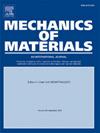Modeling of shock-induced plasticity of single-crystalline magnesium with a coupled dislocation and twinning constitutive model
IF 3.4
3区 材料科学
Q2 MATERIALS SCIENCE, MULTIDISCIPLINARY
引用次数: 0
Abstract
Despite significant attention over recent decades, the dynamic plasticity of magnesium (Mg) under high pressure and high strain rates remains far from well understood owing to the complexity of deformation under such extreme conditions. In particular, dynamic twinning plasticity is still described by phenomenological models, which limits further understanding of the dynamic mechanical response of metals. In this work, a twinning substructure model, in which twinning nucleation, propagation, and growth are taken into account, is applied to address plastic deformation of single-crystalline Mg subjected to shock compression. The model is coupled with a dislocation plasticity model under the thermoelastic–viscoplastic framework. By utilizing this combined model, a quantitative connection between the evolution of defects, including dislocations and twins, and the experimentally measured wave profiles is established. Modeling the mechanical response of single-crystalline Mg under shock compression provides new insights into the twinning-related plasticity of Mg, revealing that the typical features of the wave profile of Mg are significantly influenced by twinning, especially those along the (10–10) direction. Notably, in contrast to the classical understanding predicted by the dislocation plasticity model that deformation on the elastic precursor wavefront is purely one-dimensional elastic, the new model indicates that twinning nucleation leads to considerable plastic deformation on the elastic precursor wavefront. Additionally, plasticity along the (10–10) direction at the plastic front is demonstrated to be governed by twinning and dislocation mechanisms acting together, while the power-scaling law appears to be almost independent of the twinning mechanisms.
用位错-孪晶耦合本构模型模拟单晶镁的冲击塑性
尽管近几十年来备受关注,但由于在这种极端条件下变形的复杂性,镁(Mg)在高压和高应变率下的动态塑性仍远未得到很好的理解。特别是,动态孪生塑性仍然是用现象学模型来描述的,这限制了对金属动态力学响应的进一步理解。在这项工作中,一个孪生子结构模型,其中孪生的成核,扩展和生长被考虑在内,应用于解决单晶镁合金在冲击压缩下的塑性变形。该模型在热弹粘塑性框架下与位错塑性模型耦合。利用该组合模型,建立了缺陷(包括位错和孪晶)的演变与实验测量的波廓线之间的定量联系。模拟单晶Mg在激波压缩下的力学响应,为Mg的孪晶相关塑性提供了新的见解,揭示了Mg的波廓线的典型特征受到孪晶的显著影响,特别是沿(10-10)方向的特征。值得注意的是,与位错塑性模型预测的弹性前驱波前变形纯粹是一维弹性变形的经典理解相反,新模型表明孪晶成核导致弹性前驱波前出现相当大的塑性变形。此外,塑性前沿沿(10-10)方向的塑性受孪晶和位错机制共同作用的支配,而幂标度律似乎几乎与孪晶机制无关。
本文章由计算机程序翻译,如有差异,请以英文原文为准。
求助全文
约1分钟内获得全文
求助全文
来源期刊

Mechanics of Materials
工程技术-材料科学:综合
CiteScore
7.60
自引率
5.10%
发文量
243
审稿时长
46 days
期刊介绍:
Mechanics of Materials is a forum for original scientific research on the flow, fracture, and general constitutive behavior of geophysical, geotechnical and technological materials, with balanced coverage of advanced technological and natural materials, with balanced coverage of theoretical, experimental, and field investigations. Of special concern are macroscopic predictions based on microscopic models, identification of microscopic structures from limited overall macroscopic data, experimental and field results that lead to fundamental understanding of the behavior of materials, and coordinated experimental and analytical investigations that culminate in theories with predictive quality.
 求助内容:
求助内容: 应助结果提醒方式:
应助结果提醒方式:


